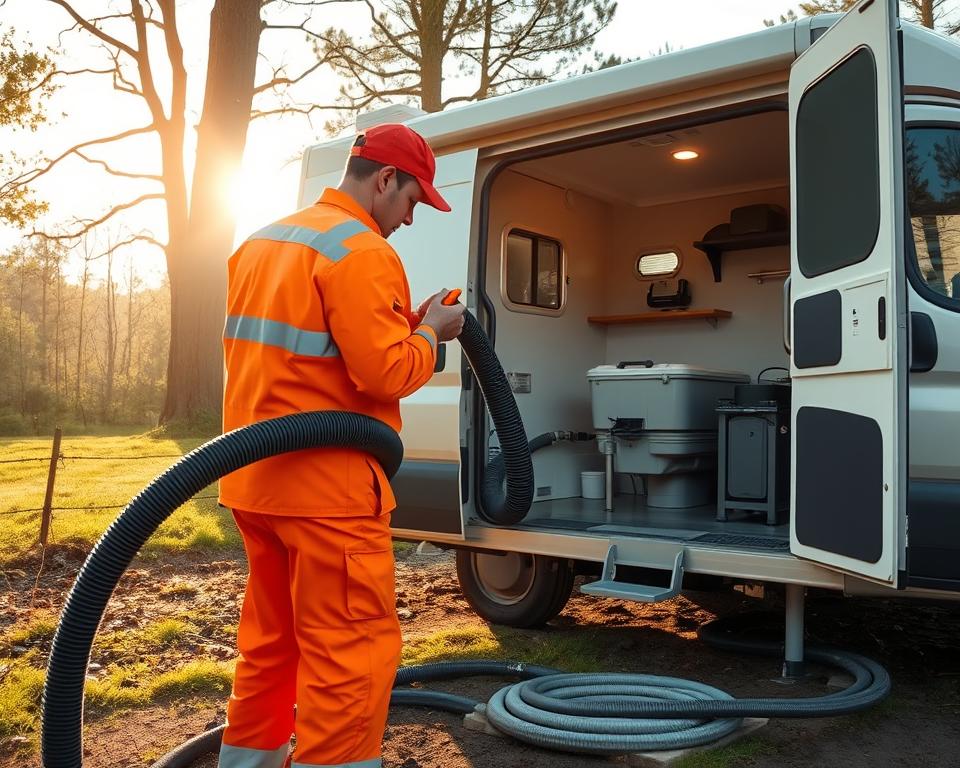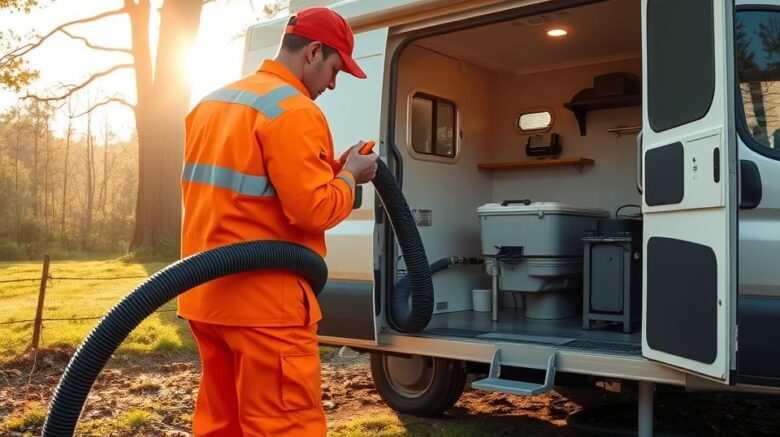Motorhome Water Tank plus Pump: Must-Read Manual
Have you ever asked how seasoned RVers maintain perfect water flow while touring? It’s chiefly due to your RV water Tank & Pump. Be it venturing into national parks or a quick weekend retreat, mastering your RV’s water system is paramount. In this guide we break down the basics: the parts, upkeep, and tips for smooth travel. Knowing each element, from the plumbing network to reservoir filling, secures water is always on tap during your outings – mobile RV pump out.
Main Points
- Understanding the RV water system optimises your travel adventure.
- The RV fresh-water Tank & Pump are central for a dependable water supply.
- Routine upkeep extends the service life of your RV plumbing.
- Knowing the right way to top up your reservoir properly can avert future issues.
- Diagnosing your water Pump can save you from sudden problems.
Getting to Know RV Water Systems
RV water systems are split into two primary parts: the potable-water setup and the grey/black-water mechanism. The clean-water circuit houses several core components like the storage Tank, pressure Pump, and faucets, mirroring home plumbing yet tailored for the ever-changing needs of living on the move.
Supplying clean water is essential for the system’s reliability. It safeguards the safety of all passengers. It’s vital to keep the RV plumbing in top shape through scheduled maintenance – including proper drainage to avoid leaks and other issues. Proactive inspections enable RV enthusiasts dodge water-related mishaps during their journeys.

The Role of the RV Water Tank
The RV fresh-water reservoir is indispensable for a successful journey. It holds the fresh water necessary for drinking, cooking, and cleaning. The volume of this Tank changes with each RV model, impacting how much water can be stored – and has a direct bearing on how long you can stay off-grid before requiring a refill.
Ensuring the RV water Tank hygienic is essential. Periodic cleaning prevents harmful contaminants, ensuring water remains safe for use. Ignoring maintenance can cause bacteria or algae growth, making the water hazardous.
Recognising the RV Tank’s role improves water management during trips. Consistent upkeep and timely refills deliver a worry-free experience. It’s crucial to have ample water for all travel needs, ensuring a smooth RV adventure.
How to Fill Your RV Water Tank
Filling your RV fresh-water reservoir requires attentive action to confirm it’s done correctly. There are two primary methods: gravity-feed filling and city-pressure filling. Understanding these methods greatly improves your RV water routine.
Gravity filling is direct. You just need a food-grade water hose. Attach this hose to a water source, then to the Tank’s opening, and allow gravity handle the fill. Always monitor the water level to avoid spills.
Using city pressure relies on a city water connection, which is faster delivery. You need to use a pressure regulator to manage water flow. Connect the hose from the municipal source to your RV. This approach provides quick and consistent supply to your reservoir.
Whichever approach you prefer, follow these vital safety tips: Consistently monitor the fill when filling to prevent overflow, and use potable water to ward off health issues. Knowing these filling and safety techniques will make your RV trips even more enjoyable.
RV Water Tank and Pump: Parts in Focus
The RV Tank-and-Pump combo are vital to any RV’s plumbing system, ensuring a consistent and dependable water supply for all your needs. The RV water Pump’s main job is to move water from the reservoir, ensuring clean water is always ready. That’s key for cooking, cleaning, and showering.
RV plumbing features different Pump types, each with distinct benefits. Diaphragm pumps are prized for their steady water pressure, while centrifugal pumps are prized for simplicity and efficiency. It’s essential to weigh flow rate, noise, and installation ease when picking your Pump.
To sum up, the RV water Tank and Pump are indispensable to your water system’s operation. A dependable Pump guarantees strong pressure and smooth flow, improving your overall travel experience.
Picking the Best-Fit RV Water Pump
Choosing the appropriate RV water Pump is vital for your water system’s optimal performance. When shopping for a Pump, factoring in several points is critical for a positive camping experience. Ensuring it pairs with your RV’s water system is key.
Keep these crucial aspects in mind:
- Flow Rate: Choose a Pump with a flow rate that suits your usage needs. A stronger flow means faster Tank refills.
- Pressure Ratings: Your RV’s various fixtures set the required pressure levels. Pick a Pump whose specs align with those needs for smooth operation.
- Noise Levels: Noise can be an issue with some Pumps. For peace and quiet, compare models for their noise output.
Brands like Shurflo and VEVOR are favourites for many RVers, and they offer distinct advantages. A thoughtful assessment of these brands will guide your purchase process.
Understanding these factors is not only important for the right purchase but also equips DIY tinkerers with key know-how for upkeep and replacements.
Hooking Up to City Water for Your RV
Hooking your RV to city water provides an uninterrupted supply of fresh water, freeing you from just using your Tank. This delivers a more enjoyable camping experience. Be sure to follow specific steps for a secure hookup.
First, identify the city water connection port on your RV. It’s often marked by a white or black connector, sometimes marked for ease. Use a potable water hose designed for RVs; this type of hose protects your water safe from contaminants.
It’s essential to install a pressure regulator before making the connection. This gadget protects your plumbing by controlling the water pressure. With the regulator in place, connect the hose from it to the water source.
Once connected, watch the water pressure. Maintain a steady, gentle flow to avoid hose damage. Check your hoses regularly for any wear or leaks and quickly replace parts as needed.
Adhering to these steps for city hookup enhances your camping convenience and helps in maintaining your RV’s condition.
Maintaining Your RV Fresh-Water Tank
Keeping your RV’s fresh-water reservoir is in good order is vital for fresh, healthy water while travelling. A sound Tank wards off bacterial growth and contamination. First up, regularly sanitise the Tank: mix water with a bit of bleach for an efficient residue-free clean.
It’s crucial to look for leaks and monitor Tank pressure. Routine checks can spot problems early, preventing expensive fixes. A consistent regimen maintains the water system in excellent health.
For optimal maintenance, use a checklist:
- Check water levels and quality frequently.
- Sanitise the Tank every six months with a bleach solution.
- Inspect for leaks in the Tank.
- Monitor Tank pressure and Pump function.
- Flush the Tank to remove any sediment buildup.
RV Water Pump Diagnostics
RV water Pump troubles can be frustrating, upending travel plans without warning. Encountering strange noises, experiencing low pressure, or suffering complete Pump failure are typical problems. Learning how to troubleshoot them can significantly enhance your trips.
Hearing odd sounds from your Pump may signal a problem. First step : check for loose connections and secure them. When there’s low water pressure, inspect hoses and fittings for leaks. Even a minuscule leak can greatly affect flow, prompt troubleshooting is critical.
If your Pump fails altogether, test electrical connections. Begin by examining the Pump’s fuse. If the fuse is fine, look further for wear or damage.
A step-by-step routine isolates and resolves water system issues. Routine maintenance and inspection secure smoother journeys.
| Issue | Possible Cause | Suggested Solution |
|---|---|---|
| Strange Noises | Loose connections | Tighten fittings |
| Low Pressure | Leaky hoses/fittings | Find & seal leaks |
| Pump Failure | Electrical fault | Check fuse/wiring |
| No Water Flow | Blocked lines | Flush obstructions |
Pointers for Efficient RV Water Use
Travelling in remote areas typically entails limited water access. Economical use in your RV is vital. By embracing smart conservation tactics, you not only manage resources well but also heighten camping satisfaction.
To squeeze every drop of water while travelling, try these tips:
- Take brief showers – aim for under five minutes.
- Install water-saving fixtures like low-flow showerheads and faucets.
- Reuse grey water: dishwater can flush toilets or water plants.
- Monitor Tank levels regularly to prevent overflow.
- Plan water stops in advance: know filling stations along your route.
In Closing
Understanding the intricacies of your RV water systems is key to a successful travel adventure. The water Tank & Pump are at the core of this, needing routine upkeep. By looking after these systems, you secure a dependable supply and avoid potential snags.
Diligent troubleshooting and checks fetter stress and spare time. Being proactive about upkeep is essential, especially when you’re far from help. Proper care allows you to optimise water use, raising comfort for everyone.
As you set off, leverage this guide to master your RV’s water systems. Making informed choices about plumbing and equipment prepare you to relish the freedom of the road. Here’s to joyous and memorable travels ahead!
